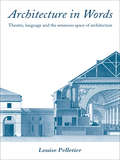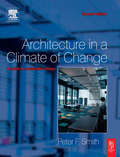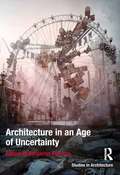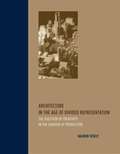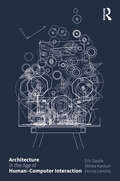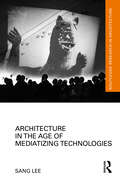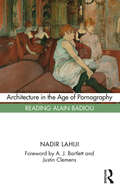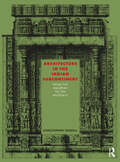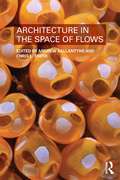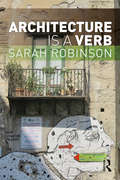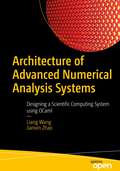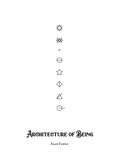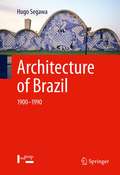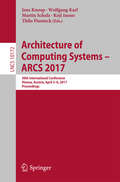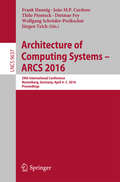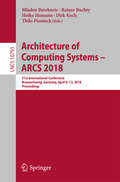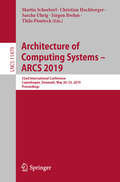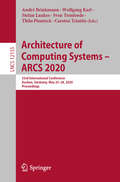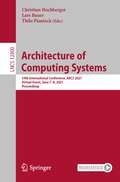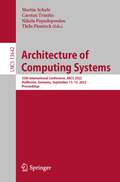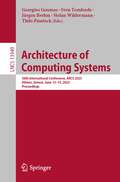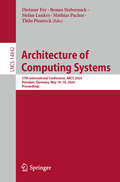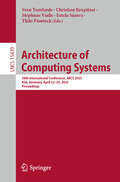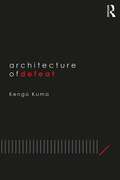- Table View
- List View
Architecture in Words: Theatre, Language and the Sensuous Space of Architecture
by Louise PelletierWhat if the house you are about to enter was built with the confessed purpose of seducing you, of creating various sensations destined to touch your soul and make you reflect on who you are? Could architecture have such power? This was the assumption of generations of architects at the beginning of modernity. Exploring the role of theatre and fiction in defining character in architecture, Louise Pelletier examines how architecture developed to express political and social intent. Applying this to the modern day, Pelletier considers how architects can learn from these eighteenth century attitudes in order to restore architecture's communicative dimension. Through an in-depth and interdisciplinary analysis of the beginning of modernity, Louise Pelletier encourages today's architects to consider the political and linguistic implications of their tools. Combining theory, historical studies and research, Architecture in Words will provoke thought and enrich the work of any architect.
Architecture in a Climate of Change
by Peter F SmithRevised to incorporate and reflect changes and advances since it was first published the new edition of Architecture in a Climate of Change provides the latest basic principals of sustainability and the future of sustainable technology.Including new material on wind generation, domestic water conservation, solar thermal electricity as well as international case studies Architecture in a Climate of Change encourages readers to consider new approaches to building making minimum demand on fossil based energy.
Architecture in an Age of Uncertainty (Ashgate Studies In Architecture Ser.)
by Benjamin FlowersIn the past two decades economic bubbles inflated and architectural spending around the globe reached fever pitch. In both well-established centers of capital accumulation and far--flung locales, audacious building projects sprang up, while the skyscraper, heretofore more commonly associated with American capitalism, seemed as if it might pack up and relocate to Dubai and Shanghai. Of course, much has changed in the past couple of years. In formerly free-spending Dubai, the tallest building in the world is now is named after the president of Abu Dhabi after he stepped in with last--minute debt financing. In cities across the United States, housing prices have nose-dived and cleared lots sit ready for commercial redevelopment that likely won't take place for another decade. Similar stories are not hard to find in many other nations. Architecture firms that swelled in flush days are jettisoning employees at a startling rate. In the context of economic instability (and its attendant social and political consequences), this edited volume brings together scholars, critics, and architects to discuss the present state of uncertainty in the practice and discipline of architecture. The chapters are organized into three main areas of inquiry: economics, practice, and technology. Within this larger framework, authors explore issues of security, ecological design, disaster architecture, the future of architectural practice, and the ethical obligations of the social practice of design. In doing so, it argues that this period has actually afforded architecture a valuable moment of self-reflection, where alternative directions for both the theory and practice of architecture might be explored rather than continuing with an approach which was so nurtured by capitalist prosperity and affluence.
Architecture in the Age of Divided Representation: The Question of Creativity in the Shadow of Production
by Dalibor VeselyIn this long-awaited work, Dalibor Vesely proposes an alternative to the narrow vision of contemporary architecture as a discipline that can be treated as an instrument or commodity.
Architecture in the Age of Human–Computer Interaction
by Eric Sauda Alireza Karduni Donna LanclosThis book investigates the spaces where architecture and computer science share a common set of assumptions and goals, using methods and objectives from architecture, ethnography, and human–computer interaction (HCI).Architecture and HCI depend on and borrow from each other, and even share some vocabulary in their divergent disciplinary agendas. The authors here unpack the past, present, and potential futures of architecture and the user interface, employing the lens of ethnography and ethnographic practices to launch this exciting cross-disciplinary inquiry. The goal is the creation of an interface that is able to connect the wide range of embodied architectural space, the modes of interaction afforded by computation, and the social process of creating meaningful places.This will be of great interest to upper-level students and academics in the fields of architecture, human–computer interaction, and ethnography.
Architecture in the Age of Mediatizing Technologies (Routledge Research in Architecture)
by Sang LeeThis book offers a novel perspective on contemporary architecture, exploring its position in mediatization, attained through technological apparatuses. It introduces the novel concepts of apparatus-centricity and mediatization of architecture, which have significant disciplinary and cultural ramifications.Highlighting key technological and theoretical developments, the book’s narrative traces the transformation of architecture from the modernist era to the present, digital age. En route, it reflects on how architecture becomes a crucial element of shifting dispositives through its confluence with technologies of aestheticization and virtualization, and by emblematizing ecological ideals. It also illuminates the reconfiguring of architectural practice through examining surprising interactions and analogies between architecture and music, whose developments in notation and codification continually change the relationship between composer and performer. The book explores how architecture is reshaped by broader theory and practice in media and ultimately serves as a cognitive agent. It underscores that architecture profoundly influences our phantasmagoric, image-driven affective world through its increasingly apparatus-centric approach to conception, design, production, and mediatization.Architecture in the Age of Mediatizing Technologies brings into focus the behavior of architecture in mediatization for researchers and advanced students in architectural design, theory, and history. As an investigation into the interdisciplinary impact of architecture in a mediatized culture at large, it also provides a valuable resource for cultural and media studies.
Architecture in the Age of Pornography: Reading Alain Badiou
by Nadir LahijiArchitecture, and its pedagogy in the academy, is dominated by the technology of image production that veils the ‘naked power’ behind its operation. It conforms to the principles of cultural logic of the society of the spectacle, consistent with neoliberal capitalism. The problem with this dominant pedagogy is that it violates the fundamental ethical imperative, putting architecture in direct contradiction with the ‘common good’. In addition, it has let architecture enter the brothel of pornographic capitalism which turns every object into an object of obscene gratification of the senses. In this book, Nadir Lahiji adopts Alain Badiou’s thesis from The Pornographic Age to demonstrate that contemporary architecture is in absolute complicity with the pornographic present. The traits that Badiou identifies in this age are manifestly visible in architectural surfaces which are subordinated to the same ‘regime of images’. Similarly to Badiou’s political indictments of the society which has given rise to the pornographic present, the book condemns the architecture that has lent its service to the same society with a license to consummate its transgression to better cater to the imperative of the ‘regime of images’. Transposing the conceptual categories in Badiou’s analysis to the critique of architecture’s pornographic turn in contemporary society, the book constructs a conceptual framework by which to demonstrate the specific manifestations of pornography in building. The book is aimed at architecture students at higher graduate and post-graduate levels.
Architecture in the Indian Subcontinent: From the Mauryas to the Mughals
by Christopher TadgellDedicated to the tracing of continuity across sectarian divides, Christopher Tadgell’s History of Architecture in India (1989) was the first modern monograph to draw together in one volume all the strands of India’s pre-colonial architectural history – from the Vedic and Native traditions of early India, through Hindu, Buddhist, Islamic and secular architecture. This comprehensive revision, Architecture in the Indian Subcontinent: From the Mauryas to the Mughals, expands the structure to acknowledge the great advance in scholarship across this extremely complex subject over the last three decades. An understanding of Indian history and religion is the basis for understanding the complex pattern of relationships in the evolution of architecture in the subcontinent. Therefore, background material covers major invasions, migrations, dynastic conflicts and cultural and commercial connections, the main religious developments and their significance and repercussions, and external architectural precedents. While avoiding the usual division of the subject into ‘Buddhist and Hindu’ and ‘Islamic’ parts in order to trace continuity, the importance of religion, symbolism and myth to the development of characteristic Indian architectural forms in all their richness and complexity is fully explained in this fully illustrated account of the subcontinent’s architecture.
Architecture in the Space of Flows
by Chris L. Smith Andrew BallantyneTraditionally, architecture has been preoccupied with the resolution of form. That concern helps to make photogenic buildings, which have received a great deal of attention. This book looks instead at the idea of the flows, which connects things together and moves between things. It is more difficult to discuss, but more necessary, because it is what makes things work. Architects have to think about flow – the flow of people through buildings, the flow of energy into buildings, and waste out of them – but usually the effects of flow do not find expression. The essays gathered here present a collection of exploratory ideas and offer an understanding of buildings, people and settlements through concepts of flow.
Architecture is a Verb
by Sarah RobinsonArchitecture is a Verb outlines an approach that shifts the fundamental premises of architectural design and practice in several important ways. First, it acknowledges the centrality of the human organism as an active participant interdependent in its environment. Second, it understands human action in terms of radical embodiment—grounding the range of human activities traditionally attributed to mind and cognition: imagining, thinking, remembering—in the body. Third, it asks what a building does—that is, extends the performative functional interpretation of design to interrogate how buildings move and in turn move us, how they shape thought and action. Finally, it is committed to articulating concrete situations by developing a taxonomy of human/building interactions. Written in engaging prose for students of architecture, interiors and urban design, as well as practicing professionals, Sarah Robinson offers richly illustrated practical examples for a new generation of designers.
Architecture of Advanced Numerical Analysis Systems: Designing a Scientific Computing System using OCaml
by Liang Wang Jianxin ZhaoThis unique open access book applies the functional OCaml programming language to numerical or computational weighted data science, engineering, and scientific applications. This book is based on the authors' first-hand experience building and maintaining Owl, an OCaml-based numerical computing library. You'll first learn the various components in a modern numerical computation library. Then, you will learn how these components are designed and built up and how to optimize their performance. After reading and using this book, you'll have the knowledge required to design and build real-world complex systems that effectively leverage the advantages of the OCaml functional programming language. What You Will LearnOptimize core operations based on N-dimensional arraysDesign and implement an industry-level algorithmic differentiation moduleImplement mathematical optimization, regression, and deep neural network functionalities based on algorithmic differentiationDesign and optimize a computation graph module, and understand the benefits it brings to the numerical computing libraryAccommodate the growing number of hardware accelerators (e.g. GPU, TPU) and execution backends (e.g. web browser, unikernel) of numerical computationUse the Zoo system for efficient scripting, code sharing, service deployment, and compositionDesign and implement a distributed computing engine to work with a numerical computing library, providing convenient APIs and high performance Who This Book Is For Those with prior programming experience, especially with the OCaml programming language, or with scientific computing experience who may be new to OCaml. Most importantly, it is for those who are eager to understand not only how to use something, but also how it is built up.
Architecture of Being
by Alan FaenaAuthored during the height of the pandemic amidst a period of self-reflection, culture and style impresario Alan Faena conceives a deeply personal framework of attributes to liberate the self in this highly personal manifesto exploring the constructs of human potential.To build my dreams, I first had to build myself. In this book I share the secrets of that Architecture. — Alan Faena As a creative with a highly personal vision of design, Alan Faena has produced some of the most extraordinary spaces in the recent past — from his ingenious reconstruction of an abandoned neighborhood in Buenos Aires to the heights of luxury in Miami Beach. Faena now presents the guiding principles that have helped him produce these urban marvels. Authored during the height of the pandemic, Faena conceived a deeply personal framework of tenets that guided his journey of self-discovery and creativity. Composed of eight thematic pillars — Creation, Vision, Weakness, Silence, Path, Present, Love and Architecture — these chapters explore the inspired source from which all creativity emanates, from the personal battles to the deliberate decisions that ultimately define Faena&’s vision and infuse his imaginative vision.
Architecture of Brazil: 1900-1990
by Hugo SegawaArchitecture of Brazil: 1900-1990 examines the processes that underpin modern Brazilian architecture under various influences and characterizes different understandings of modernity, evident in the chapter topics of this book. Accordingly, the author does not give overall preference to particular architects nor works, with the exception of a few specific works and architects, including Warchavchik, Niemeyer, Lucio Costa, and Vilanova Artigas.
Architecture of Business Intelligence: Aligning a Robust Technical Environment with Business Strategies
by Thomas H. Davenport Jeanne G. HarrisWhile improvements in technology's ability to store data can be astonishing, most organization's ability to manage, analyze, and apply data has not kept pace. In this chapter, the authors identify the technology, data, and governance processes needed for analytical competition. This chapter was originally published as Chapter 8 of "Competing on Analytics."
Architecture of Computing Systems - ARCS 2017: 30th International Conference, Vienna, Austria, April 3–6, 2017, Proceedings (Lecture Notes in Computer Science #10172)
by Martin Schulz Thilo Pionteck Jens Knoop Wolfgang Karl Koji InoueThis book constitutes the proceedings of the 30th International Conference on Architecture of Computing Systems, ARCS 2017, held in Vienna, Austria, in April 2017. The 19 full papers presented in this volume were carefully reviewed and selected from 42 submissions. They were organized in topical sections entitled: resilience; accelerators; performance; memory systems; parallelism and many-core; scheduling; power/energy.
Architecture of Computing Systems -- ARCS 2016: 29th International Conference, Nuremberg, Germany, April 4-7, 2016, Proceedings (Lecture Notes in Computer Science #9637)
by Frank Hannig João M.P. Cardoso Thilo Pionteck Dietmar Fey Wolfgang Schröder-Preikschat Jürgen TeichThis book constitutes theproceedings of the 29th International Conference on Architecture of ComputingSystems, ARCS 2016, held in Nuremberg, Germany, in April 2016. The 29 full papers presented in this volume werecarefully reviewed and selected from 87 submissions. They were organized intopical sections named: configurable and in-memory accelerators;network-on-chip and secure computing architectures; cache architectures andprotocols; mapping of applications on heterogeneous architectures and real-timetasks on multiprocessors; all about time: timing, tracing, and performancemodeling; approximate and energy-efficient computing; allocation: from memoriesto FPGA hardware modules; organic computing systems; and reliability aspects inNoCs, caches, and GPUs.
Architecture of Computing Systems – ARCS 2018: 31st International Conference, Braunschweig, Germany, April 9-12, 2018. Proceedings (Lecture Notes in Computer Science #10793)
by Dirk Koch Thilo Pionteck Heiko Hamann Mladen Berekovic Rainer BuchtyThis book constitutes the proceedings of the 31st International Conference on Architecture of Computing Systems, ARCS 2018, held in Braunschweig, Germany, in April 2018.<P><P> The 23 full papers presented in this volume were carefully reviewed and selected from 53 submissions. ARCS has always been a conference attracting leading-edge research outcomes in Computer Architecture and Operating Systems, including a wide spectrum of topics ranging from embedded and real-time systems all the way to large-scale and parallel systems.
Architecture of Computing Systems – ARCS 2019: 32nd International Conference, Copenhagen, Denmark, May 20–23, 2019, Proceedings (Lecture Notes in Computer Science #11479)
by Sascha Uhrig Thilo Pionteck Christian Hochberger Martin Schoeberl Jürgen BrehmThis book constitutes the proceedings of the 32nd International Conference on Architecture of Computing Systems, ARCS 2019, held in Copenhagen, Denmark, in May 2019. The 24 full papers presented in this volume were carefully reviewed and selected from 40 submissions. ARCS has always been a conference attracting leading-edge research outcomes in Computer Architecture and Operating Systems, including a wide spectrum of topics ranging from embedded and real-time systems all the way to large-scale and parallel systems. The selected papers are organized in the following topical sections: Dependable systems; real-time systems; special applications; architecture; memory hierarchy; FPGA; energy awareness; NoC/SoC. The chapter 'MEMPower: Data-Aware GPU Memory Power Model' is open access under a CC BY 4.0 license at link.springer.com.
Architecture of Computing Systems – ARCS 2020: 33rd International Conference, Aachen, Germany, May 25–28, 2020, Proceedings (Lecture Notes in Computer Science #12155)
by Thilo Pionteck Stefan Lankes Wolfgang Karl Sven Tomforde Carsten Trinitis André BrinkmannThis book constitutes the proceedings of the 33rd International Conference on Architecture of Computing Systems, ARCS 2020, held in Aachen, Germany, in May 2020.* The 12 full papers in this volume were carefully reviewed and selected from 33 submissions. 6 workshop papers are also included. ARCS has always been a conference attracting leading-edge research outcomes in Computer Architecture and Operating Systems, including a wide spectrum of topics ranging from embedded and real-time systems all the way to large-scale and parallel systems. The selected papers focus on concepts and tools for incorporating self-adaptation and self-organization mechanisms in high-performance computing systems. This includes upcoming approaches for runtime modifications at various abstraction levels, ranging from hardware changes to goal changes and their impact on architectures, technologies, and languages.*The conference was canceled due to the COVID-19 pandemic.
Architecture of Computing Systems: 34th International Conference, ARCS 2021, Virtual Event, June 7–8, 2021, Proceedings (Lecture Notes in Computer Science #12800)
by Lars Bauer Thilo Pionteck Christian HochbergerThis book constitutes the proceedings of the 34th International Conference on Architecture of Computing Systems, ARCS 2021, held virtually in July 2021. The 12 full papers in this volume were carefully reviewed and selected from 24 submissions. 2 workshop papers (VEFRE) are also included. ARCS has always been a conference attracting leading-edge research outcomes in Computer Architecture and Operating Systems, including a wide spectrum of topics ranging from fully integrated, self-powered embedded systems up to high-performance computing systems. It also provides a platform covering newly emerging and cross-cutting topics, such as autonomous and ubiquitous systems, reconfigurable computing and acceleration, neural networks and artificial intelligence. The selected papers cover a variety of topics from the ARCS core domains, including heterogeneous computing, memory optimizations, and organic computing.
Architecture of Computing Systems: 35th International Conference, ARCS 2022, Heilbronn, Germany, September 13–15, 2022, Proceedings (Lecture Notes in Computer Science #13642)
by Martin Schulz Thilo Pionteck Carsten Trinitis Nikela PapadopoulouThis book constitutes the proceedings of the 35th International Conference on Architecture of Computing Systems, ARCS 2022, held virtually in July 2022. The 18 full papers in this volume were carefully reviewed and selected from 35 submissions. ARCS provides a platform covering newly emerging and cross-cutting topics, such as autonomous and ubiquitous systems, reconfigurable computing and acceleration, neural networks and artificial intelligence. The selected papers cover a variety of topics from the ARCS core domains, including energy efficiency, applied machine learning, hardware and software system security, reliable and fault-tolerant systems and organic computing.
Architecture of Computing Systems: 36th International Conference, ARCS 2023, Athens, Greece, June 13–15, 2023, Proceedings (Lecture Notes in Computer Science #13949)
by Thilo Pionteck Sven Tomforde Stefan Wildermann Jürgen Brehm Georgios GoumasThis book constitutes the proceedings of the 36th International Conference on Architecture of Computing Systems, ARCS 2023, which took place in Athens, Greece, in June 2023.The 18 full papers in this volume were carefully reviewed and selected from 35 submissions.ARCS provides a platform covering newly emerging and cross-cutting topics, such as autonomous and ubiquitous systems, reconfigurable computing and acceleration, neural networks and artificial intelligence. The selected papers cover a variety of topics from the ARCS core domains, including energy efficiency, applied machine learning, hardware and software system security, reliable and fault-tolerant systems and organic computing.Back to top
Architecture of Computing Systems: 37th International Conference, ARCS 2024, Potsdam, Germany, May 14–16, 2024, Proceedings (Lecture Notes in Computer Science #14842)
by Thilo Pionteck Dietmar Fey Stefan Lankes Benno Stabernack Mathias PacherThis book constitutes the proceedings of the 37th International Conference on Architecture of Computing Systems, ARCS 2024, held in Potsdam, Germany, in May 2024. The 23 papers presented in this volume were carefully reviewed and selected from 33 submissions. These papers have been categorized in the following sections: Progress in Neural Networks; Organic Computing; Computer Architecture Co-Design; Progress in HPC; Computer Architectures; and Dependability and Fault Tolerance.
Architecture of Computing Systems: 38th International Conference, ARCS 2025, Kiel, Germany, April 22–24, 2025, Proceedings (Lecture Notes in Computer Science #15839)
by Thilo Pionteck Sven Tomforde Christian Krupitzer Stéphane Vialle Estela SuarezThis book constitutes the proceedings of the 38th International Conference on Architecture of Computing Systems, ARCS 2025, held in Kiel, Germany, in April 2025. The 24 full papers presented together with 12 other papers in this volume were carefully reviewed and selected from 49 submissions. These papers have been categorized in the following sections: self-powered embedded systems up to plant powered high-performance systems, new emerging and cross-cutting topics,such as autonomous and ubiquitous systems, reconfigurable computing, mathematical models, neural networks, and artificial intelligence.
Architecture of Defeat
by Kengo KumaKengo Kuma, one of Japan’s leading architects, has been combining professional practice and academia for most of his career. In addition to creating many internationally recognized buildings all over the world, he has written extensively about the history and theory of architecture. Like his built work, his writings also reflect his profound personal philosophy. Architecture of Defeat is no exception. Now available in English for the first time, the book explores events and architectural trends in the twentieth and twenty-first centuries in both Japan and beyond. It brings together a collection of essays which Kuma wrote after disasters such as the destruction of the World Trade Center in New York City on 9/11 and the earthquake and tsunami that obliterated much of the built landscape on Japan’s northern shore in a matter of minutes in 2011. Asking if we have been building in a manner that is too self-confident or arrogant, he examines architecture’s intrinsic—and often problematic—relationship to the powerful forces of contemporary politics, economics, consumerism, and technology, as well as its vital ties to society. Despite the title, Architecture of Defeat is an optimistic and hopeful book. Rather than anticipating the demise of architecture, Kuma envisages a different mode of conceiving architecture: guided and shaped by more modesty and with greater respect for the forces of our natural world. Beautifully designed and illustrated, this is a fascinating insight into the thinking of one of the world’s most influential architects.
